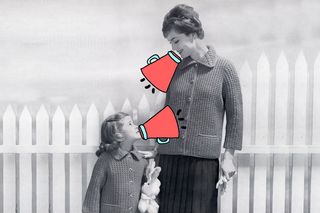
Study: Kids’ Language Development Is About Engagement, Not Vocabulary
We all know the importance of building children’s vocabulary, thanks to a landmark 1995 study which found that children from higher-income families hear about 30 million more words during their first three years of...

We all know the importance of building children’s vocabulary, thanks to a landmark 1995 study which found that children from higher-income families hear about 30 million more words during their first three years of life than children from lower-income families. This gap correlates with significant differences in tests of vocabulary, language development, and reading comprehension later in childhood.
But a new study has found it’s not just a matter of pouring words onto kids to fill this gap, or drilling them in flashcards; more influential on language development by far is conversation with a parent. The back-and-forth exchange of words and thoughts literally changes children’s brains in a way that gives them an edge.
In a study of children between the ages of 4 and 6, MIT cognitive scientists found that differences in the number of “conversational turns” accounted for a large portion of the differences in brain physiology and language skills that they found among the children. This finding applied to children regardless of parental income or education.
The findings suggest that parents can have considerable influence over their children’s language and brain development by simply engaging them in conversation, the researchers say.
“The important thing is not just to talk to your child, but to talk with your child,” says Rachel Romeo, a graduate student at Harvard and MIT and the lead author of the paper, published in the journal Psychological Science. “It’s not just about dumping language into your child’s brain, but to actually carry on a conversation with them.”
Using functional magnetic resonance imaging (fMRI), the researchers identified differences in the brain’s response to language that correlated with the number of conversational turns. In children who experienced more conversation, Broca’s area, a part of the brain involved in speech production and language processing, was much more active while they listened to stories. This brain activation then predicted children’s scores on language assessments, fully explaining the income-related differences in children’s language skills.
“The really novel thing about our paper is that it provides the first evidence that family conversation at home is associated with brain development in children. It’s almost magical how parental conversation appears to influence the biological growth of the brain,” says John Gabrieli, an MIT professor of brain and cognitive sciences and the senior author of the study.
Before this study, little was known about how the “word gap” might translate into differences in the brain. The MIT team set out to find these differences by comparing the brain scans of children from different socioeconomic backgrounds.
As part of the study, the researchers used a system called Language Environment Analysis (LENA) to record every word spoken or heard by each child. Parents who agreed to have their children participate in the study were told to have their children wear the recorder for two days, from the time they woke up until they went to bed.
The recordings were then analyzed by a computer program that yielded three measurements: the number of words spoken by the child, the number of words spoken to the child, and the number of times that the child and an adult took a “conversational turn” — a back-and-forth exchange initiated by either one.
The researchers found that the number of conversational turns correlated strongly with the children’s scores on standardized tests of language skill, including vocabulary, grammar, and verbal reasoning. The number of conversational turns also correlated with more activity in Broca’s area, when the children listened to stories while inside an fMRI scanner.
These correlations were much stronger than those between the number of words heard and language scores, and between the number of words heard and activity in Broca’s area.
This result aligns with other recent findings, Romeo says, “but there’s still a popular notion that there’s this 30-million-word gap, and we need to dump words into these kids — just talk to them all day long, or maybe sit them in front of a TV that will talk to them. However, the brain data show that it really seems to be this interactive dialogue that is more strongly related to neural processing.”
The researchers believe interactive conversation gives children more of an opportunity to practice their communication skills, including the ability to understand what another person is trying to say and to respond in an appropriate way.
While children from higher-income families were exposed to more language on average, children from lower-income families who experienced a high number of conversational turns had language skills and Broca’s area brain activity similar to those of children who came from higher-income families.
“In our analysis, the conversational turn-taking seems like the thing that makes a difference, regardless of socioeconomic status,” Gabrieli says. “Such turn-taking occurs more often in families from a higher socioeconomic status, but children coming from families with lesser income or parental education showed the same benefits from conversational turn-taking.”
The researchers hope their findings will encourage parents to engage their young children in more conversation. Although this study was done in children age 4 to 6, this type of turn-taking can also be done with much younger children, by making sounds back and forth or making faces, the researchers say.
“One of the things we’re excited about is that it feels like a relatively actionable thing because it’s specific,” he says. “That doesn’t mean it’s easy for less educated families, under greater economic stress, to have more conversation with their child. But at the same time, it’s a targeted, specific action, and there may be ways to promote or encourage that.”
Related


What Your Hug Says About You
